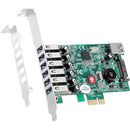Description
Upgrade your desktop’s USB capabilities with the SIIG DP USB 3.0 7-Port PCIe expansion card. This high-performance PCIe add‑on delivers seven SuperSpeed USB 3.0 Type‑A ports (six external and one internal) and leverages the renowned Renesas uPD720201/uPD720210 chipset to provide fast, reliable data transfer at up to 5 Gbps. Designed for PCIe-enabled desktops, this card enables seamless peripheral expansion, faster backups, and smoother multi‑device workflows without compromising system stability. Whether you’re a creator, gamer, data‑heavy professional, or simply looking to future‑proof an older build, the SIIG 7‑port USB 3.0 PCIe card offers a versatile, plug‑and‑play solution that unlocks the full potential of USB 3.0 devices.
- Seven USB 3.0 ports in one card: Expand your workstation with six external USB 3.0 Type‑A ports plus a convenient internal header for front‑panel USB access, delivering abundant connectivity for peripherals, external drives, joysticks, cameras, and more.
- Blazing fast data speeds: Each port supports SuperSpeed USB 3.0 with theoretical transfer rates up to 5 Gbps, enabling rapid file transfers, large media imports, and responsive external storage performance.
- Reliable Renesas USB controller technology: Built around the acclaimed Renesas uPD720201/uPD720210 chipset, the card emphasizes stable operation, efficient power management, and compatibility with a wide range of USB devices and host systems.
- PCIe expansion for desktops: Designed for PCI Express enabled desktops, the card uses a PCIe host interface to deliver high bandwidth to all seven ports while maintaining compact form factor and straightforward installation.
- Bus‑powered convenience with flexible deployment: Typically powered via the PCIe slot for ease of use; no additional external power supply is required in standard configurations, while the internal header enables front‑panel integration for convenient access to USB ports in cases with front bays.
Technical Details of SIIG DP USB 3.0 7-Port PCIe i/e
- Ports: 7 x USB 3.0 Type‑A ports (6 external, 1 internal header)
- Data transfer rate: Up to 5 Gbps per port (SuperSpeed USB 3.0)
- Chipset: Renesas uPD720201 / uPD720210 family
- Interface: PCI Express (PCIe) host connection, commonly PCIe x1
- Power delivery: Bus-powered via PCIe slot; no external power connector required for typical setups
- Compatibility: Optimized for desktops with available PCIe slots; supports USB 3.0 devices and backward compatibility with USB 2.0/1.1 peripherals
how to install SIIG DP USB 3.0 7-Port PCIe i/e
- Power down your PC and unplug the power cord. Open the computer case to access the motherboard and PCIe slots.
- Identify an available PCIe slot (preferably PCIe x1 or larger) and remove the corresponding expansion slot cover on the back of the case.
- Insert the SIIG 7‑port USB 3.0 PCIe card firmly into the PCIe slot until it is fully seated, then fasten the card’s metal bracket to the case with a screw for secure mounting.
- Reconnect power and boot the system. The operating system should recognize the new hardware and install drivers automatically in most cases; if prompted, allow the driver installation to complete.
- Connect USB devices to the external ports and, if using the internal header, attach any front‑panel USB 3.0 cable to the internal header on the card and to the corresponding motherboard header per your case’s manual. Verify that all devices are detected and functioning at USB 3.0 speeds.
Frequently asked questions
- Q: How many USB 3.0 ports does this card provide? A: Seven ports in total—six external USB 3.0 Type‑A ports plus one internal header for front‑panel USB access.
- Q: What chipset powers this card? A: The card uses the Renesas uPD720201/uPD720210 USB controller family, known for stable USB 3.0 performance and broad device compatibility.
- Q: Do I need an external power supply? A: In most standard configurations, the card is bus‑powered via the PCIe slot and does not require an external power connector. If you run exceptionally power‑hungry devices, verify your system’s power availability and consider alternative power solutions if needed.
- Q: Which systems work with this expansion card? A: The card is designed for PCIe enabled desktops and supports USB 3.0 devices with backward compatibility to USB 2.0/1.1 peripherals. For best results, install any available driver updates from your operating system.
- Q: Can I use the internal header for front‑panel USB‑Cables? A: The internal header on the card is intended for USB 3.0 Type‑A front‑panel connections, giving you convenient access to high‑speed USB on the case front.
- Q: Will this card improve performance for external drive transfers? A: Yes. With seven USB 3.0 ports and up to 5 Gbps transfer rates, you can expect noticeably faster file transfers, quicker backups, and improved data throughput for external storage devices.
- Q: Is installation difficult for non‑tech users? A: The installation follows standard PCIe expansion procedures. If you are comfortable opening a PC case and seating a PCIe card, you should be able to install and configure the card in minutes. Always power down and unplug the system before installing hardware.
Customer reviews
Showing - Of Reviews


